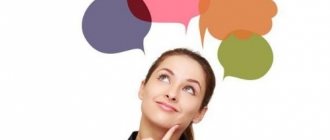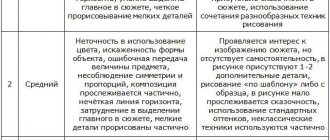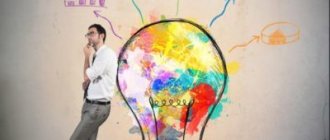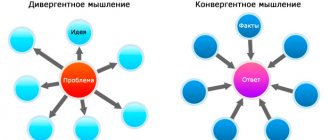Human thinking is a complex and largely mysterious process that has gone through a long path of evolution. We use it all the time, but very rarely think about its essence. Why do some people become confused when life presents them with difficult challenges? And others, seemingly without much effort, find completely original solutions that allow them not only to solve the problem that has arisen, but also to achieve success, make a career, and become a leader? Because the latter are smarter than the former?
Not at all. A huge number of people are accustomed to solving problems in a standard way, following learned rules or a given algorithm. We are taught this way in school, so when faced with a problem, we ask friends for advice or look for ready-made recipes on the Internet. And there are people who independently find a non-standard solution and even enjoy it. Why? Because they have creative thinking.
Stages of development of creative thinking
- Preparation
The initial stage of formation, at which preparation for reflection occurs, information and facts are collected for further processing of the material. At this stage, analytical thinking is affected, conditions for solving problems are created, and goals are set.
- An attempt at reflection
At the second stage, conditions for the thought process appear due to the attraction of divergent thinking. There may be disappointment, which will help you to be critical of the ideas that arise, selecting only the most unique.
- "Hatching" an idea
The stage of suspension of the creative process, distraction by other objects. It helps to distract from the delayed process of incubating an idea, look at it from the other side, soberly assessing the disadvantages and advantages, avoiding reproductive creativity.
- Creative insight
There is a creative insight, an intellectual shift from a dead point, revealing problems and solutions.
- Analysis of the work done
At the last stage, the work done is assessed and the ideas received are analyzed. It occurs through analytical thinking, using basic evaluation criteria.
All stages of creative thinking are interconnected. Consistent implementation of them helps to get the best result in the course of the work done.
Creative thinking presupposes the development of conditions for the emergence of moral and cultural principles in a person. Creative thinking helps a person express himself, his thoughts and feelings. Through creativity, a person shows character, vision of the people around him, nature and the content of his inner world.
The basis for the formation of a person’s creativity should be the following criteria for creative thinking:
- The ability to analyze, compare and synthesize, the presence of cause-and-effect relationships.
- Critical thinking, timely identification of errors and contradictions.
- The ability to predict further developments of events.
- The ability to imagine an object or object in a timeless framework, the ability to see things in the future and past tense.
- Be able to promote ideas received and develop possible options for events.
- The ability to obtain new interesting thoughts and ideas in a short period and at the lowest cost.
Types and characteristics of creative thinking
In psychology, it is customary to divide creative thinking into two types: concrete - figurative and verbal - logical. Those with concrete imaginative thinking are considered talented because they perceive the world around them in specific images. When the brain works, this type of creative thinking uses the right side of the brain, which is responsible for the emotional side of intelligence.
The verbal-logical type tends to carry out mundane abstract concepts, with a logical or verbal direction. Accordingly, this type of thinking belongs to the left hemisphere of the brain, which is responsible for logical processes and a mathematical mindset.
But the ability to be creative does not stop with one specific personality type, but can be present in everyone. Features of creative thinking help to combine images and create abstractions.
Part 1. What is creative thinking and how to measure it
Creative thinking is considered one of the key skills of the 21st century.
All enlightened people talk about the importance of its development. Unfortunately, they don’t talk about how to evaluate your creativity and whether it can be improved. My post is an attempt to provide answers to these questions using the achievements of modern science. First you need to understand what creative thinking is. I liked the following definition: Creative thinking is the creation of unusual and good solutions to an original problem. This definition breaks down the creative thinking process into two stages:
- creating unusual solutions
- choosing solutions that are good enough to deal with the problem
According to this principle, there are two types of creative thinking:
- divergent - the ability to come up with several solutions to the same problem
- convergent - the ability to choose the most optimal solution from the available ones
The main way to measure the work of divergent thinking is to give a task to come up with ways to use objects. For example, “think of as many ways to use a brick as possible.” If you have read the book Harry Potter and the Methods of Rational Thinking, you may remember the following episode. In Chapter 16, “Thinking Outside the Box,” Professor Quirrell asks Harry to come up with ten creative ways to use objects in the training room for combat. This is a standard task to test the functioning of divergent thinking, which was proposed by the famous psychologist Joy Paul Guilford, creator of the model of the structure of intelligence.
The results are assessed according to the following 4 criteria:
- Flexibility - number of unique categories of use
. Using a brick as a murder weapon or as a means of rendering a person unconscious will count as one category of use. But using a brick as an iron will fall into a new category. - Novelty - originality of use
.
This parameter is measured in two ways: subjective and objective. The subjective method
is quite simple: each of the examiners gives a rating from 1 to 5, based on their own ideas and experience.
Oddly enough, this method has extensive scientific validation. Objective method
- examiners write down how many times participants suggested using the item in a certain way. For example, a brick as a murder weapon. And then they consider the relative novelty of the proposed option. - Usefulness - practicality in use
. Everything is quite simple here. If you can use the suggested ideas in real life, then they have a high usefulness rating. You are unlikely to use a brick as an iron. A brick can be used as a murder weapon if it comes as a surprise to the victim. As for replacing a stool, it’s very likely that you’ve already done this at least once in your life. Professor Quirrel reproached Harry precisely for the low usefulness of the ideas he proposed. - Fluency is the total number of non-repeating options
. If you wrote “use a brick as a footstool” and “use a brick as a stool,” then the two options will count as one.
The performance of convergent thinking is tested using the Mednick Verbal Creativity Test (RAT test). You are offered three words. Task: choose a fourth word that will combine the other three. For example, the words “civil”, “great” and “world” are united by the word “war”. In original testing, words of different parts of speech are often used: adjective, noun, adverb, etc.
Another way is to solve visual insight puzzles. Classic task: connect nine dots using 4 straight lines without lifting the pencil from the paper. Try to solve this problem yourself. In order not to ruin the fun for those who first scroll through the entire article before reading, I will not give the correct answer to the problem. It's pretty easy to find on the Internet.
Features of creative thinking
- eccentricity
The desire to create, to create new ideas and objects that are unique in their kind. Things obtained during the creative process must have value.
- Versatility
Considering an object from another side that is not typical for it, applying a fresh look to it. An attempt to find the hidden potential, taking into account the main characteristics and traits.
- Flexible perception
The ability to change your view of the nature of a phenomenon or object. An attempt to consider the parties that can change the scope of an object and increase its uniqueness.
- Adaptability
Transition from one point of view to another. Ability to process large amounts of information and come up with interesting ideas and situations.
The connection between imagination and creative thinking in psychology
Imagination is part of creative thinking. They are closely related and are the basis of each other. Imagination connects and unites the structures of the intellect: attention, perception, memory.
Only human consciousness creates the conditions for the appearance of reality in images. This ability is associated with the mental and semantic type of thinking, combining them into one whole. Human imagination is a mysterious and inexplicable process that has not yet been fully studied. Thanks to it, conditions are created for the emergence of masterpieces of literature, sculpture and painting.
The possibilities of imagination are limitless, it shows reality from a different perspective and is of great importance for psychology and intellectual development of a person:
- Creative imagination plans actions and deeds, evaluates one’s behavior and the result obtained.
- Imagination helps you “travel” through time, calling into consciousness past events and impressions, receiving new creative ideas
- Imagination fulfills goals and objectives that are not realized in life. Some points are being made.
The human imagination processes objects and actions of different content, which contain features that have no analogues in reality. Invented objects and events are usually called fantasy, and the desired development of events is a dream.
A person's imagination can be:
- Active helps to evoke images, with the assistance of willpower. The evoked image does not always correspond to the description of the object, but carries an individual idea of it.
- Passive. Thoughts and ideas appear spontaneously, regardless of a person’s desire.
- Productive. The emergence of new ideas is associated with a person’s life experience.
- Reproductive. Reproductive imagination is the transference of experienced emotions and actions into human creativity. The reproductive imagination does not contain fictional elements.
Cognitive sphere
Creative thinking is closely related to all human cognitive abilities.
Memory
People capable of creativity have specific types of memory. Musicians - auditory, artists - visual, choreographers - motor, tasters - gustatory, sculptors - tactile, etc. And absolutely all of them have figurative and associative memory. Ordinary people, when solving a problem, use only the original material. Creative people draw on all their past experience for this, which, it would seem, is completely unrelated to the problem. Psychologists call this “high memory availability.”
Attention and concentration
Creative people are often considered distracted and unfocused. In most cases this is true. They are simply too busy with their personal perception of the environment and are not motivated to simultaneously be interested in something else. For example, at a meeting they may not listen at all to the boss’s report on summing up the results for the past quarter. At this moment, they imagine a wise eagle owl in his place (associations are triggered) or they transfer him to the shore of the azure sea and make him an animator (desired instead of actual). But when they are passionate about the creative process, they can work for hours without being distracted by anything. Neither extraneous sounds nor hunger can disturb them. Psychologists call this complete immersion and involvement.
Perception
Creative people perceive the world differently than everyone else. They are able to see in everyday things and phenomena something that pushes the boundaries of what is familiar and permissible. Only for them, Malevich’s “Black Square” is pure art in all its beauty. They are the ones who come up with household life hacks: cleaning the soles of shoes with a toothbrush, collecting mercury from the floor with tape and growing seedlings in eggshells.
Imagination
Creative thinking is impossible without imagination. Of all the cognitive abilities, they have the most visible connection. Only through the reproduction of images and associations in the mind is a person able to create something new, creative, unusual, unlike anything else.
Intelligence
There is no single answer yet as to how intelligence and creative thinking are interconnected. Many talented people who created priceless masterpieces of art had an IQ below average. But there are also those for whom it has gone off scale. The situation is exactly the same on the other side: people with high intelligence do not always have creative potential. This is especially noticeable at school. Excellent students, as a rule, are not good at music, drawing, and applied activities. But there are exceptions when a child is talented in literally everything, demonstrating high performance in both criteria.
Many tend to explain this by the convergence and divergence of thought processes. The table will clearly demonstrate what it is.
It turns out that creative thinking is the basis of the thinking of the divergent, and not the convergent.
How to Activate Creative Thinking
Psychology has developed methods for activating creative thinking. They will help eliminate the established view of things, remove reproductive thinking and free up the mind for new discoveries. These methods create special conditions for the formation of creative thinking and increasing its productivity.
- The most popular way to activate thinking in psychology is the “brainstorming” method. The definition of “brainstorming” appeared in the 40s in America. Its essence lies in the collective solution of assigned tasks, dividing those present into those who criticize and those who “suggest”.
- Another method of activating the thought process is to change the conditions of the task being performed. We mentally change the task at hand, first changing the size, then the time and cost. In the course of the proposed method, the view of the solution changes, and new ideas appear.
What promotes the development of creative thinking
The trait of creativity may appear in a child, or it may be “late,” and the creative mind will mature later. It is important to pay attention to this issue in the process of education, then creative activity will bear fruit very soon.
Note! Everything that differs from the usual perception of an individual, that can provoke an independent exit from the comfort zone, contributes to the formation of a creative direction of thinking. For example, meeting new people from a different social circle, as well as visiting unfamiliar places. It is important to awaken research interest so that the individual has thoughts about a particular phenomenon.
Diagnosis of creative abilities
You can find out your predisposition to creativity using a system such as diagnostics. It will help you understand how creative you are, your level of creativity, and identify your predisposition to creating art objects. Diagnosis of creativity is performed by assessing specific traits of creative abilities.
To be fully and reliably carried out, the diagnosis of creativity affects all elements of creative thinking, including memory, perception, dreams and imagination.
The conducted studies on the diagnosis of creative abilities and creativity are divided into 2 parts:
- Creativity
This personality diagnosis evaluates the cognitive multifunctional abilities of the individual associated with the development of intellectual abilities. This direction is represented by the works and tests of E. Torrance, S. Taylor, S. Mednick, J. Guilford. They are based on the study of the relationship between intellectual abilities and the emergence of new images and ideas.
- Personal creativity
The task of this direction is to diagnose personality psychology, the conditions for the emergence of creativity, due to the individual characteristics of a person. This study aims to find criteria for the emergence of creativity. Representatives of the direction A. Maslow, D. Bogoyavlenskaya, F. Barron.
How to take the course?
As we said, in this course we tried to cover only basic information regarding the topic of developing creative thinking. And precisely for this reason, we strongly recommend not to miss a single lesson and study them in the order in which they are presented.
As for the actual classes, it all depends on your desire and availability of free time. But the best option would be if it takes you 1-2 days to study one lesson so that the information is absorbed properly. Also try to complete all tasks and exercises, because they directly affect the result. The more you practice, the more useful the practice will be.
Tests to identify creativity abilities
J. Guilford test
The pioneering work of assessing creativity was the work of Joy Guilford. He defined the essence of creative thinking in the combination of developed original, new images and thoughts of a person. Other tests developed after him became interpretations of this work.
The Guilford creativity test is based on certain principles:
- How simply and effectively creativity abilities are revealed in practice, when solving a problem. The number of solutions and answers received in a certain amount of time is taken into account.
- Switchability or flexibility of answers, transition from one subject to another.
- Uniqueness of answers.
E. Torrance tests
Another popular method for diagnosing abilities is tests by psychologist Alice Paul Torrance. The study of creativity by E. Thorens represents parts that characterize creativity at the verbal, visual and sound levels.
Torrance tests are performed at a specified time interval. The result obtained is assessed according to certain principles:
- Execution speed, the number of solutions completed within a certain period of time.
- Variety of answers.
- Uniqueness of the proposed solutions.
- Concretization of ideas and solutions.
E. Torrance's tests were developed in the 60s and are suitable for people of all ages and young children. Torrance tests have been constantly modified and improved, and have many similar variants.
Test E. Tunik
E. Tunik’s test is aimed at determining creativity in adolescents and adults. The test helps to identify a person’s predisposition to the following criteria:
- Curiosity. An inquisitive person with an interesting character. He is interested in the world around him, is engaged in self-knowledge, loves to think and learn the structure of new things, the mechanisms of work, does interesting work, reads books, learns as much new information as possible.
- Riskiness. Risk-taking is manifested in defending one’s ideas and thoughts in front of others, is not afraid of the possible negative reaction of people to creativity, and has a strong character. A risk-taker has a goal and goes towards it, despite possible obstacles, is ready for the consequences of mistakes, and is ready to take risks to achieve the final result. Considers the opinions of other people, but does not give in to provocations.
- Imagination helps a person to come up with new events and things that never existed in reality, to see objects that have no analogues and what is hidden from the eyes of the common man. Imagination contributes to the creation of works of art and literature.
- Preparedness for difficulties. A person with a complex character studies complex phenomena and objects. He does not look for easy ways to solve assigned problems; he does everything independently, at his own peril and risk. Studying complex things is an integral part of the life of such a person.
Part 2. How to increase your creative potential
Each of us has a different ability to come up with creative solutions. Fortunately, this ability can be improved. There are two main ways:
- environmental change
- use of special techniques
I will share several principles for working with the environment that I use myself and have scientific confirmation. Several good books have been written on the topic of special techniques. I will share the list at the end of the article.
What can increase creative potential:
1. Switching between tasks You've probably heard the story about Archimedes, who came up with a solution to a problem while sitting in the bathroom. About Newton, who made his discovery while sitting in the garden under an apple tree. About Einstein, who loved to play the violin in between thoughts. All these individuals were engaged in a process that in science is usually called mind wandering.
Mind wandering is considered an important process in creative thinking. This process allows you to find non-trivial connections between ideas. The opposite of it is considered cognitive fixation - a process when you are literally fixated on the chosen solution to a problem and do not see alternative approaches.
Creative thinking itself is usually divided into two types: divergent and convergent. Divergent thinking is the ability to find multiple solutions to the same problem. Convergent thinking is to choose the most effective of these solutions.
A 2021 study found that task switching can reduce cognitive fixations and increase the effectiveness of both types of creative thinking. Moreover, for convergent thinking the effect was stronger.
The subjects were divided into three groups. Each group had 12 minutes to complete the task. The first group had to switch between tasks every 30 seconds. The second one worked in a mode that was comfortable for her. The third had to work for 6 minutes without switching on the first task, then 6 minutes on the second task.
The first group coped with the task significantly better than the other two. Interestingly, the second group showed the same result as the third. That is, we instinctively choose an ineffective strategy for working on creative tasks.
2. Come up with ideas alone, discuss collectively When working on a new product, you have to organize collective brainstorming sessions. Alas, these meetings do not always end productively.
I immediately remember the cartoon about Winnie the Pooh, where Winnie says: “These are some wrong bees, and they make the wrong honey.” It’s the same with brainstorming: it’s somehow wrong. There is a residue after the meeting that you didn’t learn anything new and wasted your time.
Science has suggested a way to solve the problem here too. The effectiveness of brainstorming can be increased by asking each participant to come up with several solutions to the problem alone. And use a joint meeting not to generate options, but to select the best from the general list. Such a simple solution increased the “novelty” of the proposed solutions.
Why it worked: group work inclines a person to make conforming decisions and the emergence of cognitive fixation. This is the tendency to become overly focused on one single solution. During group work, participants began to spin existing ideas, instead of searching for fundamentally new solutions.
3. Music The researchers decided to look at how different types of music would influence creative thinking. They selected four modes of music: calm, happy, sad and anxious. The control group worked in silence.
The functioning of divergent thinking was tested using the task “think of as many ways as possible to use a brick.” And the work of convergent thinking is done through a test of verbal creativity to find a connecting word for the other three.
It turned out that happy music increased the efficiency of divergent thinking and had almost no effect on convergent thinking. Unfortunately, for other types of music I did not find any results of influence on creativity. If you find it, I will be very happy and will add it to the article.
Here you can find original compositions from the study.
4. Humor Divergent thinking directly depends on the current emotional state. The first way to lift your mood is to listen to happy music. The second way is humor.
Spontaneous jokes relax a person and involve distracted attention instead of focused attention. This promotes the emergence of non-obvious connections between different ideas. The resulting solutions are novel and original.
Humor has a positive effect not only on the quality of the decisions themselves, but also on their quantity. In an MIT study, improv comedians came up with 20% more ideas and 25% more creative solutions than professional product designers.
You can learn a lot from professional improvisers. This is what happened with the participants in the experiment at MIT. The subjects who completed the special workshop completed the task 37% better than before the training.
One of the most effective techniques in improvisational comedy is “Yes, and.” The task: to continue the story behind the partner so that she does not lose interest. You must simultaneously agree with the previous partner and provide a clue for the next one, so that he can also continue the story in an interesting way.
5. Reproduction of ideas (recall)
The same area of the brain is responsible for reproducing information and creating new ideas. One of the benefits of replication: creating associations with other ideas. Reproduction of information creates greater potential for the generation of new ideas.
At its core, creative thinking is connecting two ordinary objects in an unusual way. Reproduction moves information from long-term to working and allows for active mental operations. This way you can combine old information with what you just learned and get a new solution.
I actively use this technique using a personal diary. I write down on paper any thought that comes to mind. In a month and a half of actively using technology, I came up with ideas for 15 projects that I want to implement in the future. I appreciate the usefulness of these ideas.
Lateral thinking by Edward de Bono
Edward de Bono was born in Malta in 1933. Doctor of Medicine, has a degree in psychology, physiology, and is the developer of the concept of lateral thinking.
Bono's definition of lateral thinking (lat. Lateralis, translated as “displaced”) is a redirected type of thinking in relation to ordinary thinking.
In his scheme, Edward de Bono attempted to find lateral thinking, which is separated from other types of thinking and has distinctive features from logical and horizontal thinking. The textbook “Lateral Thinking” by de Bono contains a description of the most effective way of thinking that helps develop creative productivity and create new, unique ideas. Edward de Bono believes that the tool for obtaining such abilities is lateral thinking.
Human memory occupies a certain place in de Bono’s developed scheme. This environment of consciousness is in constant development, but is limited by its volume. Edward de Bono perceives lateral thinking as creativity and a sense of humor, which is used as logical thinking.
Lateral thinking is like a person's developed habit of thinking differently.
Conditions have been created for the development of this skill, which are constantly used in practice. These methods described in de Bono's book were not created by him, but borrowed from Philip Kotler. They have been known and used for a long time, Edward de Bono remade them to suit his vision, explaining how they work. Previous articlePreviousNext articleNext
Types of thinking
To understand what we are talking about, I will introduce you a little to the course of “General Psychology” and explain what thinking is and what types of this process exist.
Thinking is a mental process that helps a person perceive and reflect reality in his own way. It contributes to the fact that this reflection occurs in a generalized and indirect manner.
In simple words, when a person sees a picture, he does not describe all the shades and small details in the picture, he describes it in general terms. Mediation is a description due to other mental processes: memory (he remembered the picture), attention (he concentrated), and so on.
There are several types of thinking:
- Visual-effectiveness is the first stage of development, observed in children and animals. The situation changes only with physical impact. For example, a child was given a car, but he needs to break it down to understand whether it has a seat for the driver. He operates only with what he sees, he cannot think out anything.
- Visual-figurative - a person can imagine a situation, mentally “scroll through” different options for changing it. It is associated with imagination, since new combinations of properties and objects are established in thinking. For example, a pillow is used not only for sleeping, but also for throwing and sitting on it. The child is already thinking about where it can be used.
- Verbal-logical. This is the highest mental function, since a person knows how to use verbal concepts, logic, and uses logical structures to solve various problems. A person can analyze, generalize, structure and draw conclusions.
These are the main types identified by science, but there are also varieties that determine the individual nature of thinking.
- Theoretical. A person can analyze a phenomenon, its characteristics, change them in the process of analysis and find new ways of action, and this helps solve many problems. It is used mainly in science, when scientists invent something new.
- Practical. Very similar to the previous one - the same processes: analysis, goal setting, plans. But due to a lack of time (which often happens), problem solving occurs faster, which makes this type more difficult.
- Creative. A person in thinking creates his own, new product, new neural connections conditionally mature, which leads to the development of personality: motivation for activity appears, setting goals, assessments and meanings. A person does not think in stereotypes; he has productive thinking.
- Prological. Awareness of various phenomena from the point of view of belief in invisible forces. These are the usual superstitions, jealousy, etc.
- Reproductive. A person acts and thinks according to given patterns, and does not bring anything of his own into the thinking process.
- Critical thinking. A person builds logical connections and learns new things based on his own conclusions. He does not take everything “on faith,” but tests his beliefs on his own.











